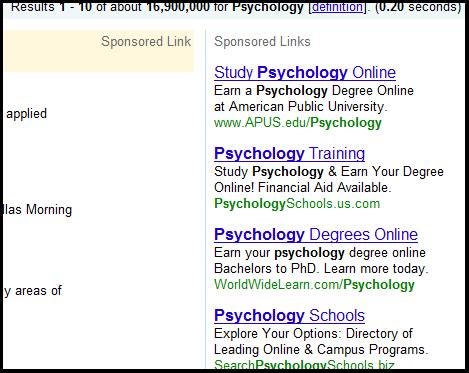Online Advertising
Routes of Communication
It is clear that online advertising is the newest road to the future of advertising. By now, just about everyone with access to the internet is familiar with the terms pop-up, spam, and banner advertisements. After the Global Network Navigator (GNN) sold the first clickable banner ad in the early 90’s, online advertising has boomed. Companies have learned that the online consumer isn’t a “passive couch-surfer” and that online advertisements are interrupting an active user and surfing around for information or entertainment (“Online advertising needs,” 2009). The route of communication chosen can determine the effectiveness of an advertisement. This section will take a brief look into the different kinds of online advertising used today, and how they’re changing.
Text-Based Advertising
 Have you ever received an email advertising a new product or giving you a valuable coupon? Text-based advertising is one of the easiest forms of communication companies can use to entice and attract consumers. Currently, one of the most popular forms of text-based advertising would be through SMS (Short Message Service) advertisements. SMS ads have much to offer marketers. The advertising message in SMS texts can be up to 160 characters, stored in the consumers’ device, and forwarded later if they wish (Wei, Xiaoming, & Pan, 2010). Text can include product information, coupons, and other information useful to consumers. In Wei, Xiaoming, and Pan’s research, they found that if a mobile phone user responds positively to the SMS advertisement, the ad can be very effective in resulting in a purchase (Wei et al.). However, advertisers must be careful with text-based advertising because individuals use their mobile devices as their own “personal space” and when their privacy is invaded with unwanted messages, the advertisement will lose all effectiveness (Taylor, 2009). SMS messages should be informative, engaging, permission-based, and benefit the receiver (Wei et al.). Therefore, if marketers are careful about their frequency of use, and message content, text-based advertising can be a very effective route of communication.
Have you ever received an email advertising a new product or giving you a valuable coupon? Text-based advertising is one of the easiest forms of communication companies can use to entice and attract consumers. Currently, one of the most popular forms of text-based advertising would be through SMS (Short Message Service) advertisements. SMS ads have much to offer marketers. The advertising message in SMS texts can be up to 160 characters, stored in the consumers’ device, and forwarded later if they wish (Wei, Xiaoming, & Pan, 2010). Text can include product information, coupons, and other information useful to consumers. In Wei, Xiaoming, and Pan’s research, they found that if a mobile phone user responds positively to the SMS advertisement, the ad can be very effective in resulting in a purchase (Wei et al.). However, advertisers must be careful with text-based advertising because individuals use their mobile devices as their own “personal space” and when their privacy is invaded with unwanted messages, the advertisement will lose all effectiveness (Taylor, 2009). SMS messages should be informative, engaging, permission-based, and benefit the receiver (Wei et al.). Therefore, if marketers are careful about their frequency of use, and message content, text-based advertising can be a very effective route of communication.
Banner Advertisements
Not only do advertisers are able to employ the text-based route of communication, but they also have other options which include banner advertisements. Online banner ads have been used for years and can go unnoticed because of the sheer volume on the internet. What most internet consumers don’t realize is that there is a massive amount of work that goes on behind the scenes with online advertising. Advertising companies that are selling banner space have the choice of two pricing options: pay-per-view (PPV) and pay-per-click (PPC). With the PPV option, the company pays each time a possible consumer opens the webpage and sees the advertisement. Opposite of that is PPC, for which the company only pays if the advertisement is clicked on (Fjell, 2009).
 Today, in a world where advertisements are found in every corner, especially while searching the internet, it is harder and harder for marketers to get their message heard. In an article by Nic Howell, he claims that less than 5% of social network users have ever clicked on a banner advertisement (Howell, 2009). Facebook, as an example of a social networking site, had 350 million users as of December 2009. If only 5% clicked on a banner ad that is 17,500,000 banner ad clicks. While that doesn’t sound like too low of a number in theory, in actuality the number could be much higher. As an advertiser, it is important to pick the right route of communication to get the message across to individuals, and banner advertisements may not be the most effective based on this statistic.
Today, in a world where advertisements are found in every corner, especially while searching the internet, it is harder and harder for marketers to get their message heard. In an article by Nic Howell, he claims that less than 5% of social network users have ever clicked on a banner advertisement (Howell, 2009). Facebook, as an example of a social networking site, had 350 million users as of December 2009. If only 5% clicked on a banner ad that is 17,500,000 banner ad clicks. While that doesn’t sound like too low of a number in theory, in actuality the number could be much higher. As an advertiser, it is important to pick the right route of communication to get the message across to individuals, and banner advertisements may not be the most effective based on this statistic.
Interactive Advertising
Over the last couple years, online advertising has transformed into more of an interactive route of communication. Numerous studies show that when consumers are engaged, they are more likely to be responsive to the advertisement. An article by Calder, Malthouse, and Schaedel, found that there are two different types of engagement- personal and social-interactive engagement. Personal engagement is shown through experiences that are similar to what individuals read in magazines and newspapers. Social-interactive engagement, involves the experiences unique to the internet, like discussion boards and social-networking sites. The authors concluded that online media involves a distinct form of engagement which impacts online effectiveness (Calder, Malthouse, & Schaedel, 2009). Another point would be that the internet has the ability to engage an individual for a long period of time and can go into greater depth than other forms of advertising media. Theses engaging features like voting, chatting, etc., are essential for consumer engagement and thus, increasing the advertisement effectiveness (Taylor, 2009).
Needless to say, online advertising is a growing and changing area of marketing today. The many different routes of communication to choose from are essential to whether or not an advertisement is successful. Text-based, banner, and interactive routes of communication are just some of the many forms of online advertising.